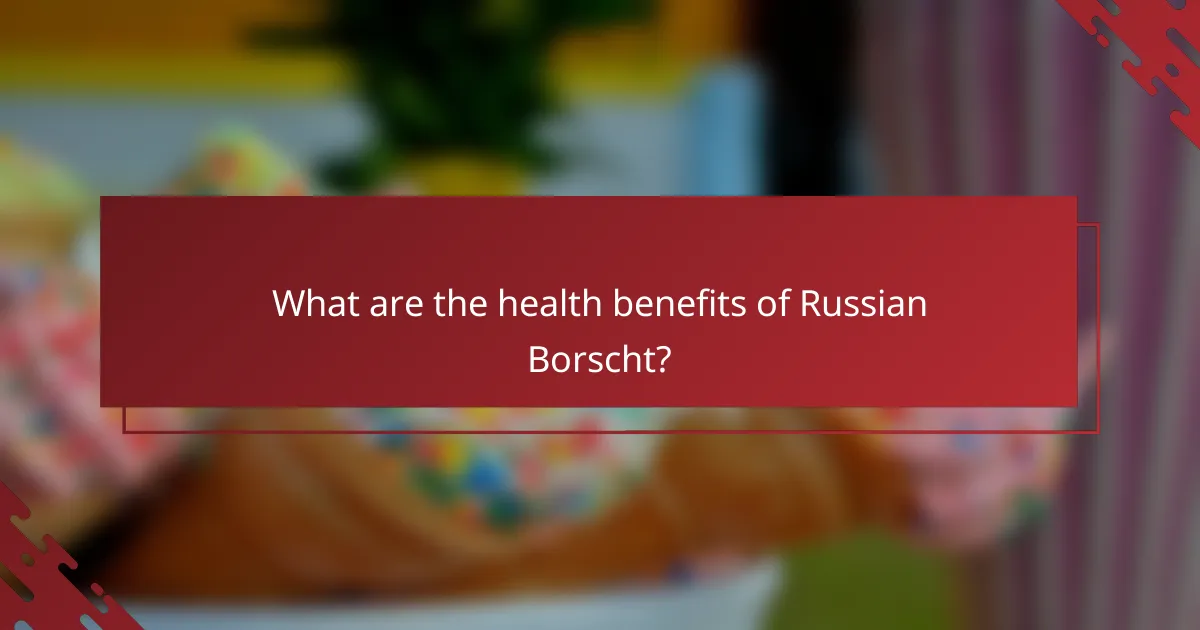Russian Borscht is a traditional Eastern European soup primarily made from beets, characterized by its deep red color. This dish typically includes ingredients such as cabbage, potatoes, carrots, and meat, commonly beef or pork, and can be served hot or cold with garnishes like sour cream and fresh herbs. The article explores the health benefits of Borscht, noting its rich vitamin content, dietary fiber, and antioxidants that support immune function, digestive health, and blood pressure regulation. Additionally, it details various cooking methods, including boiling, sautéing, and simmering, which enhance the soup’s flavor and texture, reflecting its cultural significance in Russian and Ukrainian cuisines.

What is Russian Borscht?
Russian Borscht is a traditional soup known for its deep red color, primarily made from beets. This dish often includes ingredients such as cabbage, potatoes, carrots, and meat, typically beef or pork. Borscht is served hot or cold and is commonly garnished with sour cream and fresh herbs. The soup has origins in Eastern European cuisine, particularly associated with Russian and Ukrainian cultures. It is celebrated for its rich flavor and nutritional content, offering vitamins and minerals from its vegetable base. Historical references date back to the 14th century, highlighting its long-standing significance in regional diets.
How is Russian Borscht traditionally prepared?
Russian Borscht is traditionally prepared by simmering beets, cabbage, and other vegetables in a meat or vegetable broth. First, beets are peeled and grated, then sautéed with onions and carrots to enhance their flavor. The sautéed mixture is added to the broth, along with diced potatoes and shredded cabbage. This mixture is simmered until all vegetables are tender. Finally, the soup is seasoned with salt, pepper, and vinegar for acidity. Traditionally, borscht is served hot, often garnished with sour cream and fresh dill. This preparation method has roots in Eastern European cuisine, highlighting the use of seasonal ingredients.
What ingredients are essential for making authentic Russian Borscht?
Beetroot, cabbage, potatoes, carrots, onions, and meat are essential for making authentic Russian Borscht. These ingredients create the dish’s signature flavor and texture. Beetroot provides the characteristic deep red color. Cabbage adds a crunchy texture and balances the sweetness of the beets. Potatoes contribute heartiness to the soup. Carrots enhance sweetness and depth of flavor. Onions add aromatic qualities. Meat, typically beef or pork, enriches the broth. Together, these ingredients form a traditional recipe that has been passed down through generations in Russian cuisine.
What variations exist in the preparation of Russian Borscht?
Variations in the preparation of Russian Borscht include differences in ingredients and cooking methods. Traditional recipes often feature beets, cabbage, potatoes, and carrots. Some variations incorporate meat, like beef or pork, while others are vegetarian. The use of different broths, such as chicken or vegetable, alters the flavor profile. Regional differences exist, with some areas adding beans or mushrooms. Cooking times may vary, affecting the texture of vegetables. Additionally, some recipes include sour cream as a topping, while others use vinegar for acidity. Each variation contributes to a unique taste experience of Russian Borscht.
What are the regional variations of Russian Borscht?
Russian Borscht has several regional variations. Each region incorporates local ingredients and culinary traditions. In Ukraine, borscht often includes kidney beans and is served with sour cream. In Poland, it may contain mushrooms and is sometimes served as a clear broth. The Russian version typically features beets, cabbage, and meat, often beef or pork. In the Baltic states, borscht can be made with smoked fish. In the Far East, it might include seafood, reflecting local cuisine. Each variation reflects the cultural influences and available resources of the region.
How do different regions influence the ingredients used in Borscht?
Different regions influence the ingredients used in Borscht by incorporating local produce and culinary traditions. In Ukraine, traditional Borscht often features beets, cabbage, and potatoes. This reflects the agricultural abundance of these vegetables in the region. In Russia, variations may include meat, such as beef or pork, showcasing regional preferences for heartier dishes.
In Poland, Borscht might be served with sour cream and dill, emphasizing local dairy and herb usage. The Baltic states often add fish, highlighting coastal fishing practices. Each region’s climate and available ingredients shape the unique Borscht recipes. Historical trade routes and cultural exchanges also contribute to ingredient variations. For instance, the introduction of spices from Asia influenced some Borscht recipes in Eastern Europe.
What are some popular regional recipes for Russian Borscht?
Popular regional recipes for Russian Borscht include Ukrainian Borscht, which features beets, cabbage, and meat, often served with sour cream. Another variant is Lithuanian Borscht, known as “Šaltibarščiai,” which is a cold beet soup made with kefir and served in summer. In Belarus, Borscht often incorporates potatoes and is usually heartier. The Russian version typically includes beef and is garnished with fresh herbs. Each region tailors the recipe based on local ingredients and cultural preferences. These variations highlight the adaptability of Borscht across different Slavic cultures.

What are the health benefits of Russian Borscht?
Russian Borscht offers several health benefits. It is rich in vitamins A and C from beets, which support immune function. The soup is high in dietary fiber, promoting digestive health. Additionally, Borscht contains antioxidants that help reduce inflammation. The presence of potassium in beets aids in regulating blood pressure. Borscht can also be low in calories, making it a beneficial choice for weight management. Studies show that the consumption of beets may improve exercise performance due to increased blood flow. Overall, Russian Borscht is a nutritious dish that contributes positively to health.
How does the nutritional content of Borscht contribute to health?
Borscht is a nutrient-rich soup that contributes positively to health. It is primarily made from beets, which are high in vitamins A, C, and K. These vitamins support immune function and skin health. Borscht also contains fiber, aiding in digestion and promoting gut health. The soup often includes vegetables like cabbage and carrots, which provide additional antioxidants and nutrients. Antioxidants help reduce inflammation and combat oxidative stress in the body. Furthermore, the low-calorie content of Borscht makes it a beneficial option for weight management. Overall, the combination of vitamins, fiber, and antioxidants in Borscht supports overall health and well-being.
What vitamins and minerals are found in Borscht?
Borscht contains several vitamins and minerals. Key vitamins include vitamin C, vitamin A, and several B vitamins like B6 and B12. Important minerals found in borscht are potassium, magnesium, and iron. The presence of beets contributes to its high vitamin and mineral content. Vitamin C supports immune function, while potassium is essential for heart health. The variety of vegetables used in borscht enhances its nutritional profile. Overall, borscht is a nutrient-rich dish that provides essential vitamins and minerals.
How does Borscht support digestive health?
Borscht supports digestive health primarily due to its high fiber content. The beets and vegetables in borscht provide dietary fiber, which aids in regular bowel movements. Fiber helps to prevent constipation and promotes a healthy gut. Additionally, borscht is often made with fermented ingredients like sour cream or kvass. These ingredients introduce probiotics, which enhance gut flora. A balanced gut flora is essential for optimal digestion and nutrient absorption. Studies show that fiber-rich diets can lower the risk of digestive disorders. Therefore, borscht contributes positively to digestive health through its fiber and probiotic components.
Are there any specific health benefits linked to the main ingredients?
Yes, there are specific health benefits linked to the main ingredients of Russian borscht. Beets, a primary ingredient, are rich in nitrates, which can improve blood flow and lower blood pressure. They also contain antioxidants that may reduce inflammation. Cabbage, another key ingredient, is high in vitamin C and fiber, promoting a healthy immune system and digestive health. Carrots provide beta-carotene, which supports eye health. Garlic, often included, has been shown to have antimicrobial properties and may enhance heart health. These ingredients collectively contribute to a nutrient-dense dish that supports overall well-being.
What role does beetroot play in the health benefits of Borscht?
Beetroot is a primary ingredient in Borscht, contributing significant health benefits. It is rich in vitamins and minerals, particularly vitamin C, folate, and potassium. These nutrients support immune function, promote red blood cell production, and help regulate blood pressure. Beetroot also contains antioxidants, such as betalains, which combat oxidative stress. Research indicates that beetroot may enhance athletic performance by improving blood flow and lowering blood pressure. Additionally, dietary nitrates in beetroot can support cardiovascular health. Thus, beetroot plays a crucial role in Borscht’s overall health benefits.
How do other ingredients enhance the nutritional value of Borscht?
Other ingredients enhance the nutritional value of Borscht by providing essential vitamins, minerals, and antioxidants. For example, beets are rich in folate and manganese. Carrots add beta-carotene, which is vital for eye health. Cabbage contributes vitamin K and fiber, promoting digestive health. Potatoes supply potassium, which is important for heart function. Garlic offers allicin, known for its immune-boosting properties. Additionally, herbs like dill and parsley enhance flavor while providing further nutrients. These combined ingredients create a nutrient-dense dish that supports overall health.

What cooking methods can be used to prepare Russian Borscht?
Russian Borscht can be prepared using various cooking methods. The primary methods include boiling, sautéing, and simmering. Boiling involves cooking beets and other vegetables in water to extract flavors. Sautéing is used to brown onions and garlic, enhancing the dish’s aroma. Simmering allows the ingredients to meld together over low heat, creating a rich flavor. These methods are traditional in Russian cuisine, ensuring a hearty and flavorful soup.
How can Borscht be cooked using traditional methods?
Borscht can be cooked using traditional methods by following a specific process. Start by preparing the ingredients, which typically include beets, cabbage, potatoes, carrots, and onions. Next, sauté the onions and carrots in a pot with oil until they are soft. Then, add grated beets and cook for several minutes. Following this, incorporate chopped potatoes and shredded cabbage into the pot. Pour in vegetable or meat broth and bring the mixture to a boil. Reduce the heat and let it simmer for about 30 to 40 minutes until the vegetables are tender. Finally, season with salt, pepper, and a splash of vinegar for acidity. Serve hot, often garnished with sour cream and fresh dill. This method reflects traditional Ukrainian and Russian cooking practices, emphasizing the use of fresh, seasonal ingredients.
What is the significance of slow cooking in Borscht preparation?
Slow cooking is significant in Borscht preparation because it enhances the flavors and texture of the ingredients. The prolonged cooking time allows the beets and vegetables to soften and release their natural sweetness. This method also promotes the melding of flavors, resulting in a richer and more complex taste. Additionally, slow cooking helps to preserve the nutritional value of the ingredients. Studies show that cooking vegetables at lower temperatures can maintain vitamins and minerals. Therefore, slow cooking is essential for achieving the traditional taste and health benefits of Borscht.
How does the cooking method affect the flavor of Borscht?
The cooking method significantly affects the flavor of Borscht. Different methods can enhance or alter the taste profile. For example, simmering allows flavors to meld and develop depth. Boiling may lead to a lighter taste, as ingredients cook quickly and lose some essence. Roasting vegetables before adding them can intensify their sweetness and richness. Additionally, using a slow cooker can result in a more complex flavor, as the long cooking time extracts more from the ingredients. The choice of cooking method ultimately influences the balance of sweetness, acidity, and earthiness in the final dish.
What modern techniques can be used to make Borscht?
Sous vide cooking can be used to make Borscht. This technique involves vacuum-sealing ingredients and cooking them in a temperature-controlled water bath. It allows for precise temperature control, enhancing flavor and texture.
Blending techniques, such as using an immersion blender, can create a smooth consistency. This modern method simplifies the process of pureeing the soup directly in the pot.
Pressure cooking is another technique that significantly reduces cooking time. It infuses flavors quickly and retains nutrients effectively.
Using an electric slow cooker allows for hands-off cooking. Ingredients can simmer for hours, developing deep flavors without constant supervision.
These modern techniques improve efficiency and flavor in Borscht preparation.
How can pressure cooking be applied to Borscht preparation?
Pressure cooking can significantly reduce the cooking time for Borscht. Traditional Borscht preparation can take over an hour, while pressure cooking can condense this to about 30 minutes. The high-pressure environment helps to extract flavors from ingredients quickly. Vegetables like beets, cabbage, and carrots soften faster in a pressure cooker. Additionally, the sealed environment preserves nutrients better than conventional methods. This method also enhances the soup’s overall flavor profile due to the retention of steam and aromas. Using a pressure cooker for Borscht is efficient and nutritious.
What are the benefits of using a blender for Borscht?
Using a blender for Borscht provides a smooth and consistent texture. This is essential for blending cooked vegetables and beets evenly. A blender can also save time compared to manual mashing or chopping. It allows for quick incorporation of ingredients, enhancing overall flavor integration. Furthermore, blending can help release nutrients from vegetables, making them more bioavailable. Studies show that pureeing vegetables can increase the absorption of certain vitamins. Overall, a blender simplifies the cooking process while improving the dish’s nutritional profile.
What tips can enhance the preparation of Russian Borscht?
Use fresh, high-quality ingredients to enhance Russian Borscht. Fresh beets provide better flavor and color. Incorporate a variety of vegetables for depth. Common vegetables include carrots, potatoes, and cabbage. Cooking beets separately before adding them can intensify their sweetness. Adding vinegar or lemon juice balances the flavors and brightens the dish. Allow the borscht to simmer for at least an hour to develop a rich taste. Serve with a dollop of sour cream for creaminess. Garnishing with fresh herbs like dill adds freshness and aroma.
Russian Borscht is a traditional Eastern European soup primarily made from beets, along with ingredients such as cabbage, potatoes, carrots, and meat. This article explores the various regional variations of Borscht, detailing traditional and modern cooking methods, essential ingredients, and the health benefits associated with its nutritional content. Additionally, it discusses how different regions influence the ingredients and preparation techniques, showcasing the adaptability of this dish across cultures. The article also highlights the significance of cooking methods and offers tips to enhance the preparation of authentic Borscht.